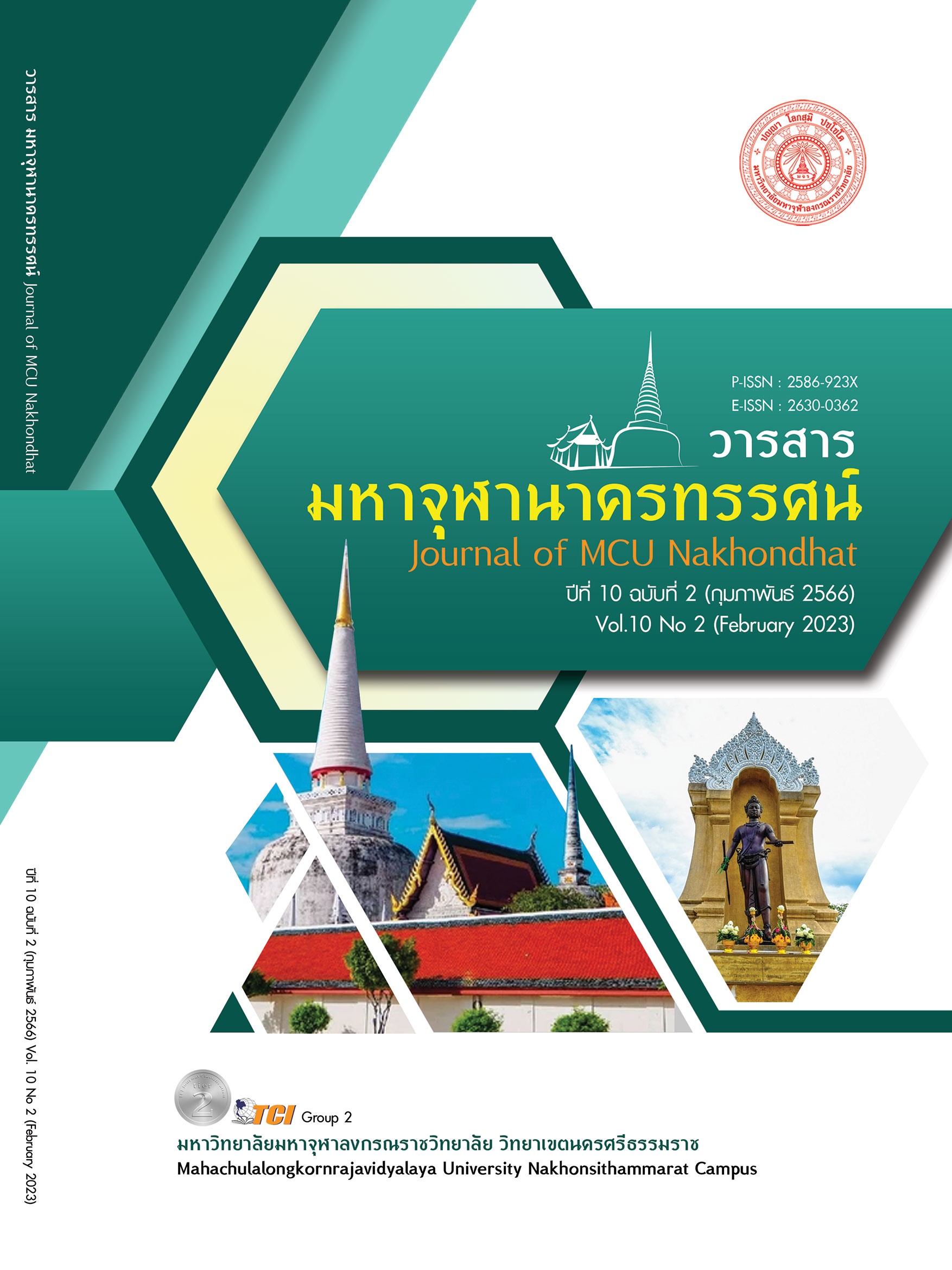LESSONS LEARNED ON AREA - BASED PROMOTING PHYSICAL ACTIVITY FOR HEALTHY PUBLIC POLICY
Main Article Content
Abstract
The objectives of this research article were to study the lesson learned on promoting physical activity for healthy public policy. Forty key informants comprised ten executives, permanent secretaries, members of local administrative organizations council, seven staffs from local administrative organizations, six project mentors, seven staffs from provincial and district public health offices and sub-district health promoting hospitals, and ten who are responsible for physical activity jobs. The data were collected by reviewing secondary data, in-depth interviews, and focus group discussions between April and July 2022. Then, the data were verified by data and methods triangulation and analyzed by content analysis. The results found that the area context can be separated into four characteristics: urban society, agricultural society, Muslim society, and traditional fishing society. The mechanisms for promoting physical activity policies were three main issues: 1) the development of physical activity leaders; both official and natural leaders to inspire the others; 2) the development of operational mechanisms with other networks in the communities and providing areas for promoting physical activity in the communities, both public areas, areas in the elderly schools and local community schools. Physical activity of community members conformed with the community lifestyle attached to local culture and local wisdom such as dancing through body language, retro dance, baslobe, kite surfing, exercising with traditional equipment: i.e., loincloths and sand cylinders, and physical activities linked to tourism including agricultural tourism, cultural tourism, and natural tourism; and 3) the development of the supporting system through the program of developing and monitoring projects, and the local mentors from local government organizations, health service units, educational institutions, and local health security funds.
Article Details

This work is licensed under a Creative Commons Attribution-NonCommercial-NoDerivatives 4.0 International License.
References
ฐิติกร โตโพธิ์ไทย และคณะ. (2562). บทเรียนจากการพัฒนาแผนการส่งเสริมกิจกรรมทางกาย พ.ศ. 2561-2573. วารสารวิจัยระบบสาธารณสุข, 13(4), 442-456.
ตัวแทนผู้รับผิดชอบงานกิจกรรมทางกายท่านที่ 1. (8 เมษายน. 2565). การขับเคลื่อนโครงการ/กิจกรรมด้านกิจกรรมทางกายในพื้นที่. (ญัตติพงศ์ แก้วทอง, ผู้สัมภาษณ์)
ตัวแทนผู้รับผิดชอบงานกิจกรรมทางกายท่านที่ 2. (7 เมษายน. 2565). การขับเคลื่อนโครงการ/กิจกรรมด้านกิจกรรมทางกายในพื้นที่. (ญัตติพงศ์ แก้วทอง, ผู้สัมภาษณ์)
ตัวแทนผู้รับผิดชอบงานกิจกรรมทางกายท่านที่ 3. (25 มีนาคม. 2565). การขับเคลื่อนโครงการ/กิจกรรมด้านกิจกรรมทางกายในพื้นที่. (ญัตติพงศ์ แก้วทอง, ผู้สัมภาษณ์)
ตัวแทนพี่เลี้ยงโครงการ/กองทุนท่านที่ 1. (5 กรกฎาคม. 2565). กลไกการทำงาน และการขับเคลื่อนโครงการ/กิจกรรมด้านกิจกรรมทางกายในพื้นที่. (ญัตติพงศ์ แก้วทอง, ผู้สัมภาษณ์)
ตัวแทนพี่เลี้ยงโครงการ/กองทุนท่านที่ 2. (25 มีนาคม. 2565). กลไกการทำงาน และการขับเคลื่อนโครงการ/กิจกรรมด้านกิจกรรมทางกายในพื้นที่. (ญัตติพงศ์ แก้วทอง, ผู้สัมภาษณ์)
ตัวแทนพี่เลี้ยงโครงการ/กองทุนท่านที่ 3. (7 เมษายน. 2565). กลไกการทำงาน และการขับเคลื่อนโครงการ/กิจกรรมด้านกิจกรรมทางกายในพื้นที่. (ญัตติพงศ์ แก้วทอง, ผู้สัมภาษณ์)
ตัวแทนสำนักงานสาธารณสุขท่านที่ 1. (20 พฤษภาคม. 2565). สถานการณ์พื้นที่ กลไกการทำงานด้านกิจกรรมทางกายในพื้นที่. (ญัตติพงศ์ แก้วทอง, ผู้สัมภาษณ์)
ตัวแทนสำนักงานสาธารณสุขท่านที่ 2. (20 พฤษภาคม. 2565). การพัฒนาและขับเคลื่อนโครงการ/กิจกรรมด้านกิจกรรมทางกายในพื้นที่. (ญัตติพงศ์ แก้วทอง, ผู้สัมภาษณ์)
ตัวแทนองค์กรปกครองส่วนท้องถิ่นท่านที่ 1. (7 เมษายน. 2565). การขับเคลื่อนโครงการ/กิจกรรมด้านกิจกรรมทางกายในพื้นที่. (ญัตติพงศ์ แก้วทอง, ผู้สัมภาษณ์)
ตัวแทนองค์กรปกครองส่วนท้องถิ่นท่านที่ 2. (24 มีนาคม. 2565). การขับเคลื่อนโครงการ/กิจกรรมด้านกิจกรรมทางกายในพื้นที่. (ญัตติพงศ์ แก้วทอง, ผู้สัมภาษณ์)
ตัวแทนองค์กรปกครองส่วนท้องถิ่นท่านที่ 4. (26 พฤษภาคม. 2565). การขับเคลื่อนโครงการ/กิจกรรมด้านกิจกรรมทางกายในพื้นที่. (ญัตติพงศ์ แก้วทอง, ผู้สัมภาษณ์)
บัณฑิต ศรไพศาล และคณะ . (2563). โมเดลพลังสี่ภาคส่วนสู่การยกระดับการทำงานป้องกันและควบคุมโรคไม่ติดต่อเรื้อรัง. วารสารวิชาการสาธารณสุข, 29(4), 747-764.
ปิยะธิดา นาคะเกษียร. (2558). กฎบัตรออตตาวากับบทบาทการสร้างเสริมสุขภาพของพยาบาลวิชาชีพ. วารสารพยาบาลศาสตร์ มหาวิทยาลัยมหิดล, 33(4), 6-14.
อัจฉรา ปุราคม และคณะ. (2563). นโยบายกิจกรรมทางกายในผู้สูงอายุ: การทบทวนวรรณกรรมอย่างเป็นระบบ. วารสารวิจัยระบบสาธารณสุข, 14(2), 208-224.
Ball, K. et al. (2015). Addressing the social determinants of inequities in physical activity and sedentary behaviours. Health Promotion International, 30 (2), 8-19.
Linzalone, N. et al. (2014). Health Impact Assessment Practice and Potential for Integration within Environmental Impact and Strategic Environmental Assessments in Italy. International Journal of Environmental Research and Public Health, 11(12), 12683-12699.
Reimers, C. D. et al. (2012). Does physical activity increase life expectancy? A review of the literature. Journal of Aging Research, 2012(1), 1-9.
Ren, Y. et al. (2021). Nutrition Transition with Accelerating Urbanization? Empirical Evidence from Rural China. Nutrients, 13(3), 1-18.
Stevens, M. et al. (2022). Equipping Physical Activity Leaders to Facilitate Behaviour Change: An Overview, Call to Action, and Roadmap for Future Research. Sports Medicine - Open, 8(1), 1-9.
Stolz, D. et al. (2014). Predictors of success for smoking cessation at the workplace: A longitudinal study. Respiration; International Review of Thoracic Diseases, 87(1), 18-25.
Topothai, T. et al. (2022). The Assessment of Physical Activity Programs Implementation in the Thai Urban-Setting against the Global Action Plan on Physical Activity Strategic Actions. Journal of Health Systems Research, 16(1), 69-84.
Wang et al. (2022). Association between socio-economic factors and the risk of overweight and obesity among Chinese adults: A retrospective cross-sectional study from the China Health and Nutrition Survey. Global Health Research and Policy, 7(1), 1-10.
World Health Organization. (2018). Global action plan on physical activity 2018-2030: More active people for a healthier world. Retrieved August 3, 2022, from https://apps.who.int/iris/handle/10665/272722
World Health Organization. (2021). Fair Play: Building a strong physical activity system for more active people. Retrieved August 3, 2022, from https://www.who.int/publications-detail-redirect/WHO-HEP-HPR-RUN-2021.1


